Service Improvement: Oral Hygiene and Patient Outcomes in Hospitals
VerifiedAdded on 2022/08/18
|7
|3756
|22
Report
AI Summary
This report examines the critical role of service improvement (SI) in healthcare, emphasizing the significance of oral hygiene in hospitals. It begins by defining SI and its historical context, highlighting the need for sustained improvements in patient care and safety, as well as the impact of the Francis Report. The report then identifies challenges in implementing SI, such as convincing healthcare workers of the need for change and addresses how to tackle this. It analyzes external pressures on the NHS, including financial constraints and increasing demands due to an aging population, and how SI can help. The report proposes focusing on oral hygiene as a key area for improvement, particularly for elderly patients, and provides a rationale for this choice, supported by evidence-based practice guidelines and research. The report highlights the negative impacts of poor oral hygiene on patient outcomes and the benefits of improved oral care. The report emphasizes the need for nurses to improve their knowledge and confidence in oral hygiene, including the importance of brushing and flossing. The report also stresses the importance of teamwork, leadership, and time management skills in successful SI implementation.
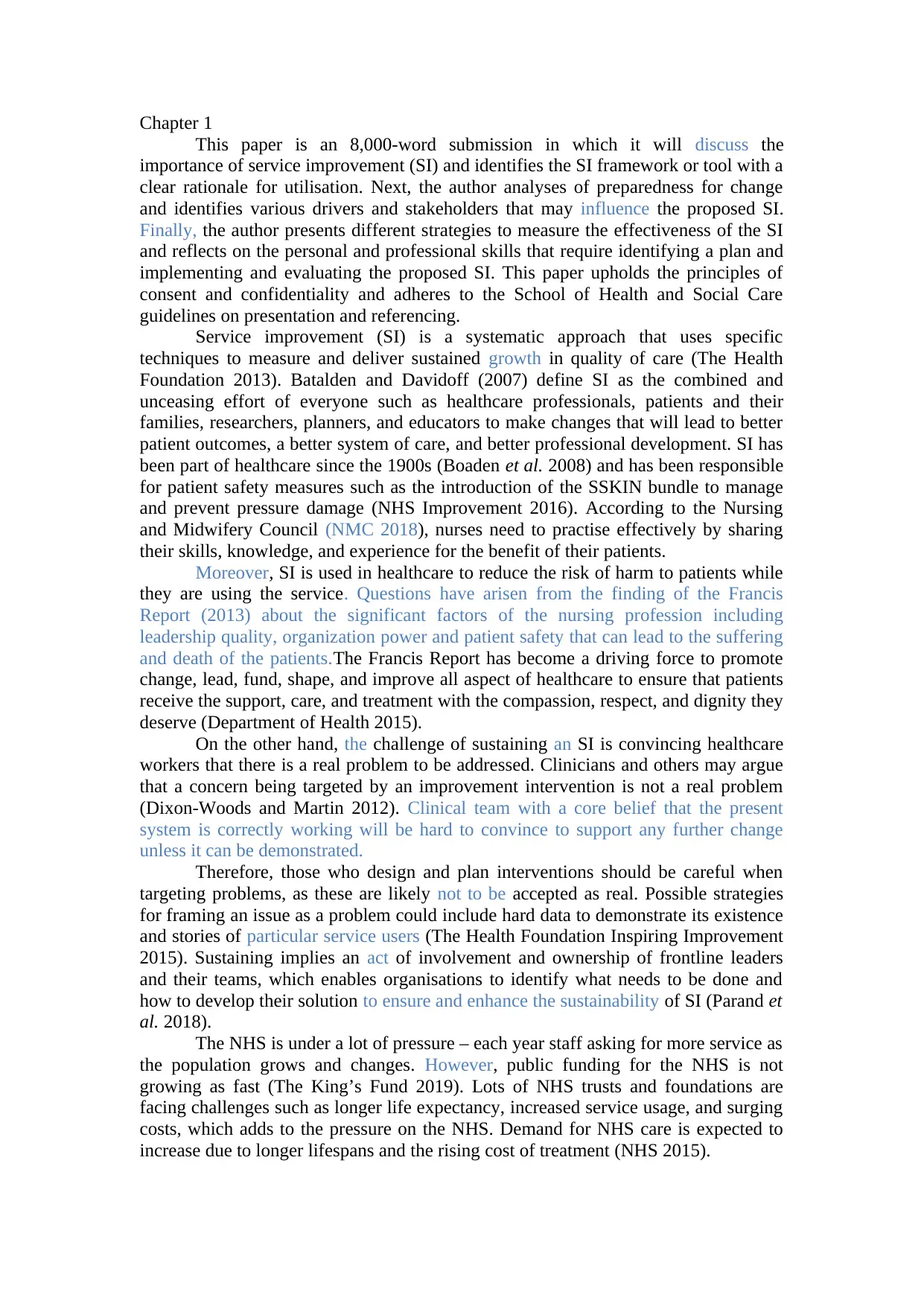
Chapter 1
This paper is an 8,000-word submission in which it will discuss the
importance of service improvement (SI) and identifies the SI framework or tool with a
clear rationale for utilisation. Next, the author analyses of preparedness for change
and identifies various drivers and stakeholders that may influence the proposed SI.
Finally, the author presents different strategies to measure the effectiveness of the SI
and reflects on the personal and professional skills that require identifying a plan and
implementing and evaluating the proposed SI. This paper upholds the principles of
consent and confidentiality and adheres to the School of Health and Social Care
guidelines on presentation and referencing.
Service improvement (SI) is a systematic approach that uses specific
techniques to measure and deliver sustained growth in quality of care (The Health
Foundation 2013). Batalden and Davidoff (2007) define SI as the combined and
unceasing effort of everyone such as healthcare professionals, patients and their
families, researchers, planners, and educators to make changes that will lead to better
patient outcomes, a better system of care, and better professional development. SI has
been part of healthcare since the 1900s (Boaden et al. 2008) and has been responsible
for patient safety measures such as the introduction of the SSKIN bundle to manage
and prevent pressure damage (NHS Improvement 2016). According to the Nursing
and Midwifery Council (NMC 2018), nurses need to practise effectively by sharing
their skills, knowledge, and experience for the benefit of their patients.
Moreover, SI is used in healthcare to reduce the risk of harm to patients while
they are using the service. Questions have arisen from the finding of the Francis
Report (2013) about the significant factors of the nursing profession including
leadership quality, organization power and patient safety that can lead to the suffering
and death of the patients.The Francis Report has become a driving force to promote
change, lead, fund, shape, and improve all aspect of healthcare to ensure that patients
receive the support, care, and treatment with the compassion, respect, and dignity they
deserve (Department of Health 2015).
On the other hand, the challenge of sustaining an SI is convincing healthcare
workers that there is a real problem to be addressed. Clinicians and others may argue
that a concern being targeted by an improvement intervention is not a real problem
(Dixon-Woods and Martin 2012). Clinical team with a core belief that the present
system is correctly working will be hard to convince to support any further change
unless it can be demonstrated.
Therefore, those who design and plan interventions should be careful when
targeting problems, as these are likely not to be accepted as real. Possible strategies
for framing an issue as a problem could include hard data to demonstrate its existence
and stories of particular service users (The Health Foundation Inspiring Improvement
2015). Sustaining implies an act of involvement and ownership of frontline leaders
and their teams, which enables organisations to identify what needs to be done and
how to develop their solution to ensure and enhance the sustainability of SI (Parand et
al. 2018).
The NHS is under a lot of pressure – each year staff asking for more service as
the population grows and changes. However, public funding for the NHS is not
growing as fast (The King’s Fund 2019). Lots of NHS trusts and foundations are
facing challenges such as longer life expectancy, increased service usage, and surging
costs, which adds to the pressure on the NHS. Demand for NHS care is expected to
increase due to longer lifespans and the rising cost of treatment (NHS 2015).
This paper is an 8,000-word submission in which it will discuss the
importance of service improvement (SI) and identifies the SI framework or tool with a
clear rationale for utilisation. Next, the author analyses of preparedness for change
and identifies various drivers and stakeholders that may influence the proposed SI.
Finally, the author presents different strategies to measure the effectiveness of the SI
and reflects on the personal and professional skills that require identifying a plan and
implementing and evaluating the proposed SI. This paper upholds the principles of
consent and confidentiality and adheres to the School of Health and Social Care
guidelines on presentation and referencing.
Service improvement (SI) is a systematic approach that uses specific
techniques to measure and deliver sustained growth in quality of care (The Health
Foundation 2013). Batalden and Davidoff (2007) define SI as the combined and
unceasing effort of everyone such as healthcare professionals, patients and their
families, researchers, planners, and educators to make changes that will lead to better
patient outcomes, a better system of care, and better professional development. SI has
been part of healthcare since the 1900s (Boaden et al. 2008) and has been responsible
for patient safety measures such as the introduction of the SSKIN bundle to manage
and prevent pressure damage (NHS Improvement 2016). According to the Nursing
and Midwifery Council (NMC 2018), nurses need to practise effectively by sharing
their skills, knowledge, and experience for the benefit of their patients.
Moreover, SI is used in healthcare to reduce the risk of harm to patients while
they are using the service. Questions have arisen from the finding of the Francis
Report (2013) about the significant factors of the nursing profession including
leadership quality, organization power and patient safety that can lead to the suffering
and death of the patients.The Francis Report has become a driving force to promote
change, lead, fund, shape, and improve all aspect of healthcare to ensure that patients
receive the support, care, and treatment with the compassion, respect, and dignity they
deserve (Department of Health 2015).
On the other hand, the challenge of sustaining an SI is convincing healthcare
workers that there is a real problem to be addressed. Clinicians and others may argue
that a concern being targeted by an improvement intervention is not a real problem
(Dixon-Woods and Martin 2012). Clinical team with a core belief that the present
system is correctly working will be hard to convince to support any further change
unless it can be demonstrated.
Therefore, those who design and plan interventions should be careful when
targeting problems, as these are likely not to be accepted as real. Possible strategies
for framing an issue as a problem could include hard data to demonstrate its existence
and stories of particular service users (The Health Foundation Inspiring Improvement
2015). Sustaining implies an act of involvement and ownership of frontline leaders
and their teams, which enables organisations to identify what needs to be done and
how to develop their solution to ensure and enhance the sustainability of SI (Parand et
al. 2018).
The NHS is under a lot of pressure – each year staff asking for more service as
the population grows and changes. However, public funding for the NHS is not
growing as fast (The King’s Fund 2019). Lots of NHS trusts and foundations are
facing challenges such as longer life expectancy, increased service usage, and surging
costs, which adds to the pressure on the NHS. Demand for NHS care is expected to
increase due to longer lifespans and the rising cost of treatment (NHS 2015).
Paraphrase This Document
Need a fresh take? Get an instant paraphrase of this document with our AI Paraphraser
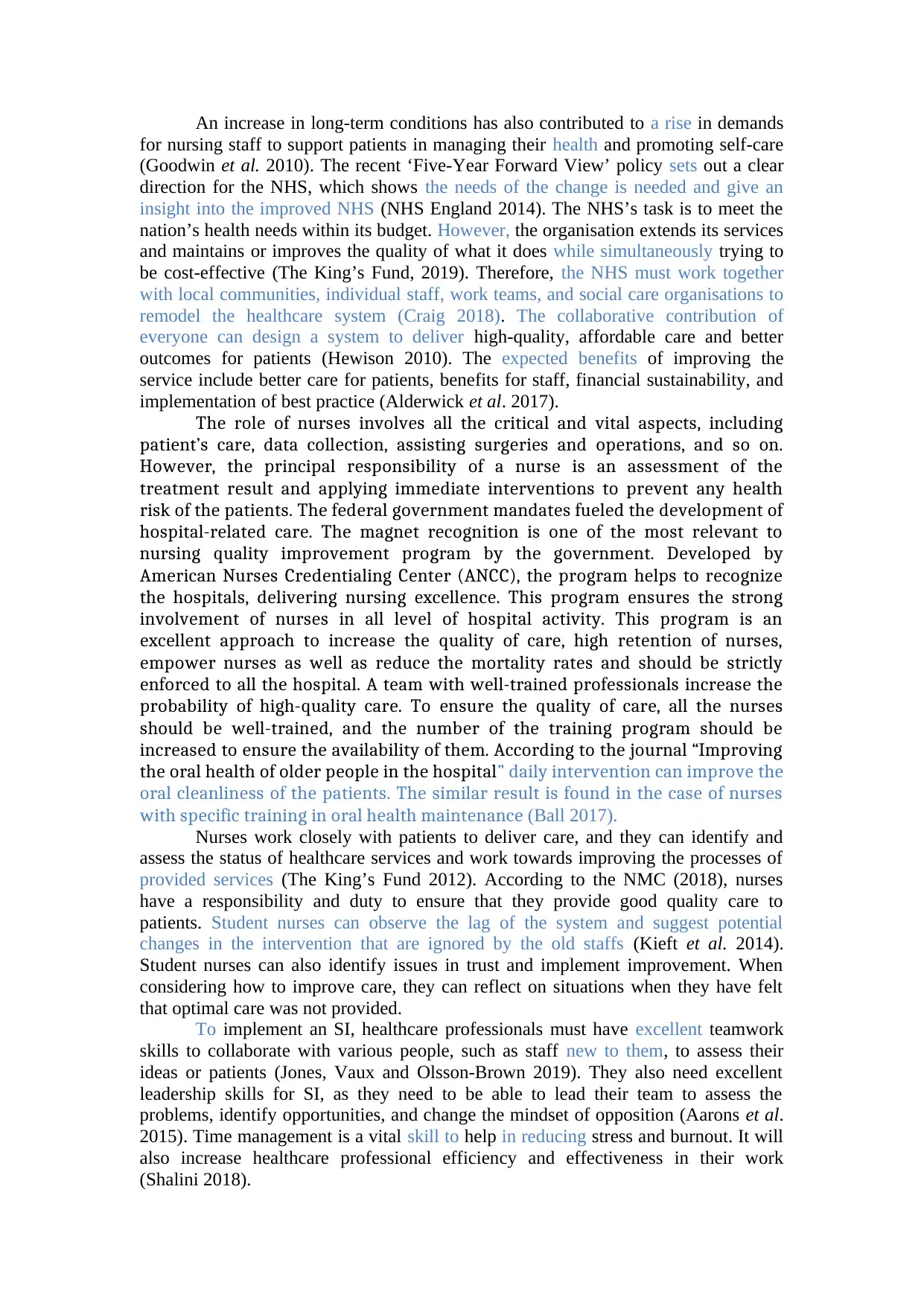
An increase in long-term conditions has also contributed to a rise in demands
for nursing staff to support patients in managing their health and promoting self-care
(Goodwin et al. 2010). The recent ‘Five-Year Forward View’ policy sets out a clear
direction for the NHS, which shows the needs of the change is needed and give an
insight into the improved NHS (NHS England 2014). The NHS’s task is to meet the
nation’s health needs within its budget. However, the organisation extends its services
and maintains or improves the quality of what it does while simultaneously trying to
be cost-effective (The King’s Fund, 2019). Therefore, the NHS must work together
with local communities, individual staff, work teams, and social care organisations to
remodel the healthcare system (Craig 2018). The collaborative contribution of
everyone can design a system to deliver high-quality, affordable care and better
outcomes for patients (Hewison 2010). The expected benefits of improving the
service include better care for patients, benefits for staff, financial sustainability, and
implementation of best practice (Alderwick et al. 2017).
The role of nurses involves all the critical and vital aspects, including
patient’s care, data collection, assisting surgeries and operations, and so on.
However, the principal responsibility of a nurse is an assessment of the
treatment result and applying immediate interventions to prevent any health
risk of the patients. The federal government mandates fueled the development of
hospital-related care. The magnet recognition is one of the most relevant to
nursing quality improvement program by the government. Developed by
American Nurses Credentialing Center (ANCC), the program helps to recognize
the hospitals, delivering nursing excellence. This program ensures the strong
involvement of nurses in all level of hospital activity. This program is an
excellent approach to increase the quality of care, high retention of nurses,
empower nurses as well as reduce the mortality rates and should be strictly
enforced to all the hospital. A team with well-trained professionals increase the
probability of high-quality care. To ensure the quality of care, all the nurses
should be well-trained, and the number of the training program should be
increased to ensure the availability of them. According to the journal “Improving
the oral health of older people in the hospital” daily intervention can improve the
oral cleanliness of the patients. The similar result is found in the case of nurses
with specific training in oral health maintenance (Ball 2017).
Nurses work closely with patients to deliver care, and they can identify and
assess the status of healthcare services and work towards improving the processes of
provided services (The King’s Fund 2012). According to the NMC (2018), nurses
have a responsibility and duty to ensure that they provide good quality care to
patients. Student nurses can observe the lag of the system and suggest potential
changes in the intervention that are ignored by the old staffs (Kieft et al. 2014).
Student nurses can also identify issues in trust and implement improvement. When
considering how to improve care, they can reflect on situations when they have felt
that optimal care was not provided.
To implement an SI, healthcare professionals must have excellent teamwork
skills to collaborate with various people, such as staff new to them, to assess their
ideas or patients (Jones, Vaux and Olsson-Brown 2019). They also need excellent
leadership skills for SI, as they need to be able to lead their team to assess the
problems, identify opportunities, and change the mindset of opposition (Aarons et al.
2015). Time management is a vital skill to help in reducing stress and burnout. It will
also increase healthcare professional efficiency and effectiveness in their work
(Shalini 2018).
for nursing staff to support patients in managing their health and promoting self-care
(Goodwin et al. 2010). The recent ‘Five-Year Forward View’ policy sets out a clear
direction for the NHS, which shows the needs of the change is needed and give an
insight into the improved NHS (NHS England 2014). The NHS’s task is to meet the
nation’s health needs within its budget. However, the organisation extends its services
and maintains or improves the quality of what it does while simultaneously trying to
be cost-effective (The King’s Fund, 2019). Therefore, the NHS must work together
with local communities, individual staff, work teams, and social care organisations to
remodel the healthcare system (Craig 2018). The collaborative contribution of
everyone can design a system to deliver high-quality, affordable care and better
outcomes for patients (Hewison 2010). The expected benefits of improving the
service include better care for patients, benefits for staff, financial sustainability, and
implementation of best practice (Alderwick et al. 2017).
The role of nurses involves all the critical and vital aspects, including
patient’s care, data collection, assisting surgeries and operations, and so on.
However, the principal responsibility of a nurse is an assessment of the
treatment result and applying immediate interventions to prevent any health
risk of the patients. The federal government mandates fueled the development of
hospital-related care. The magnet recognition is one of the most relevant to
nursing quality improvement program by the government. Developed by
American Nurses Credentialing Center (ANCC), the program helps to recognize
the hospitals, delivering nursing excellence. This program ensures the strong
involvement of nurses in all level of hospital activity. This program is an
excellent approach to increase the quality of care, high retention of nurses,
empower nurses as well as reduce the mortality rates and should be strictly
enforced to all the hospital. A team with well-trained professionals increase the
probability of high-quality care. To ensure the quality of care, all the nurses
should be well-trained, and the number of the training program should be
increased to ensure the availability of them. According to the journal “Improving
the oral health of older people in the hospital” daily intervention can improve the
oral cleanliness of the patients. The similar result is found in the case of nurses
with specific training in oral health maintenance (Ball 2017).
Nurses work closely with patients to deliver care, and they can identify and
assess the status of healthcare services and work towards improving the processes of
provided services (The King’s Fund 2012). According to the NMC (2018), nurses
have a responsibility and duty to ensure that they provide good quality care to
patients. Student nurses can observe the lag of the system and suggest potential
changes in the intervention that are ignored by the old staffs (Kieft et al. 2014).
Student nurses can also identify issues in trust and implement improvement. When
considering how to improve care, they can reflect on situations when they have felt
that optimal care was not provided.
To implement an SI, healthcare professionals must have excellent teamwork
skills to collaborate with various people, such as staff new to them, to assess their
ideas or patients (Jones, Vaux and Olsson-Brown 2019). They also need excellent
leadership skills for SI, as they need to be able to lead their team to assess the
problems, identify opportunities, and change the mindset of opposition (Aarons et al.
2015). Time management is a vital skill to help in reducing stress and burnout. It will
also increase healthcare professional efficiency and effectiveness in their work
(Shalini 2018).
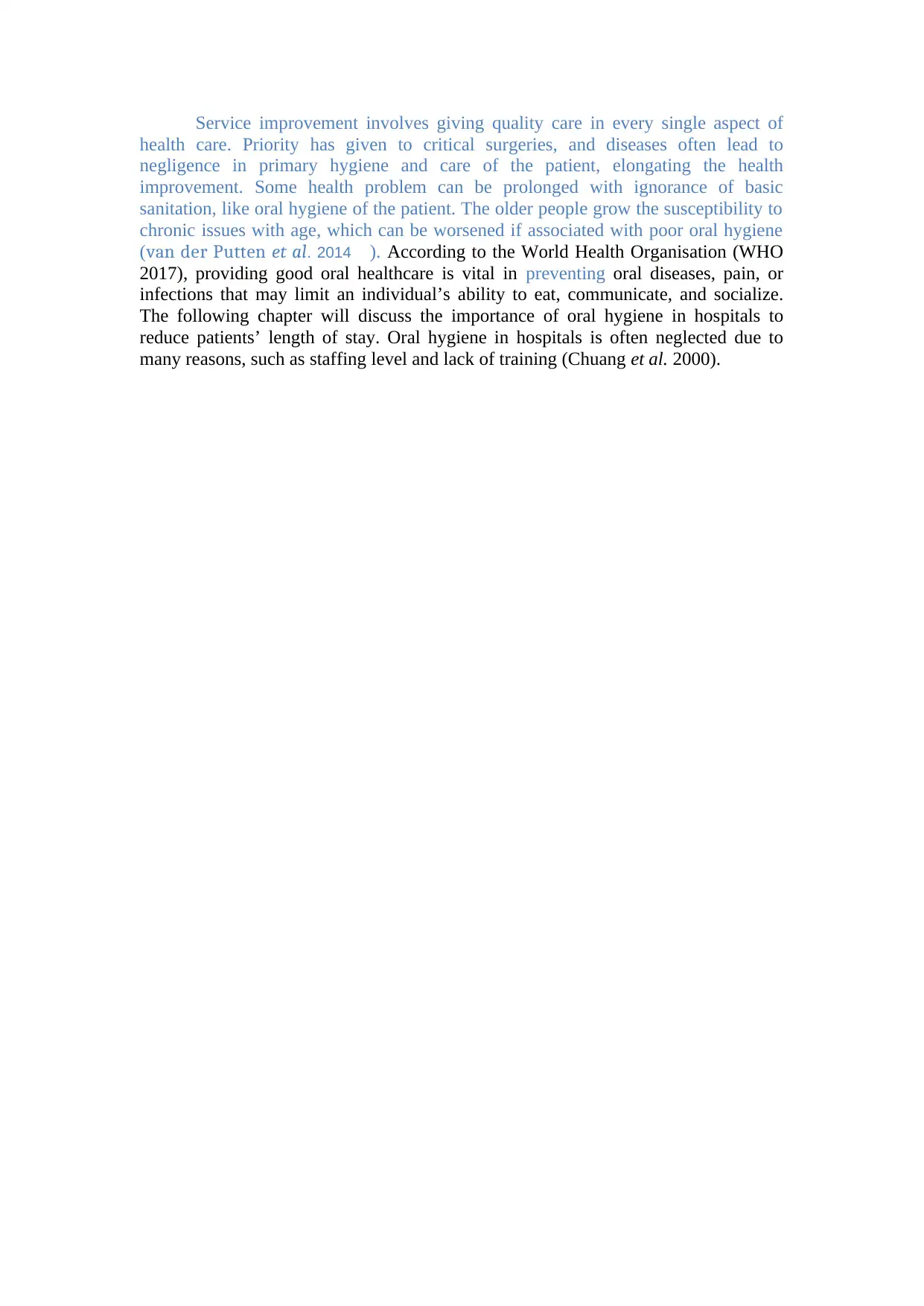
Service improvement involves giving quality care in every single aspect of
health care. Priority has given to critical surgeries, and diseases often lead to
negligence in primary hygiene and care of the patient, elongating the health
improvement. Some health problem can be prolonged with ignorance of basic
sanitation, like oral hygiene of the patient. The older people grow the susceptibility to
chronic issues with age, which can be worsened if associated with poor oral hygiene
(van der Putten et al. 2014 ). According to the World Health Organisation (WHO
2017), providing good oral healthcare is vital in preventing oral diseases, pain, or
infections that may limit an individual’s ability to eat, communicate, and socialize.
The following chapter will discuss the importance of oral hygiene in hospitals to
reduce patients’ length of stay. Oral hygiene in hospitals is often neglected due to
many reasons, such as staffing level and lack of training (Chuang et al. 2000).
health care. Priority has given to critical surgeries, and diseases often lead to
negligence in primary hygiene and care of the patient, elongating the health
improvement. Some health problem can be prolonged with ignorance of basic
sanitation, like oral hygiene of the patient. The older people grow the susceptibility to
chronic issues with age, which can be worsened if associated with poor oral hygiene
(van der Putten et al. 2014 ). According to the World Health Organisation (WHO
2017), providing good oral healthcare is vital in preventing oral diseases, pain, or
infections that may limit an individual’s ability to eat, communicate, and socialize.
The following chapter will discuss the importance of oral hygiene in hospitals to
reduce patients’ length of stay. Oral hygiene in hospitals is often neglected due to
many reasons, such as staffing level and lack of training (Chuang et al. 2000).
⊘ This is a preview!⊘
Do you want full access?
Subscribe today to unlock all pages.

Trusted by 1+ million students worldwide
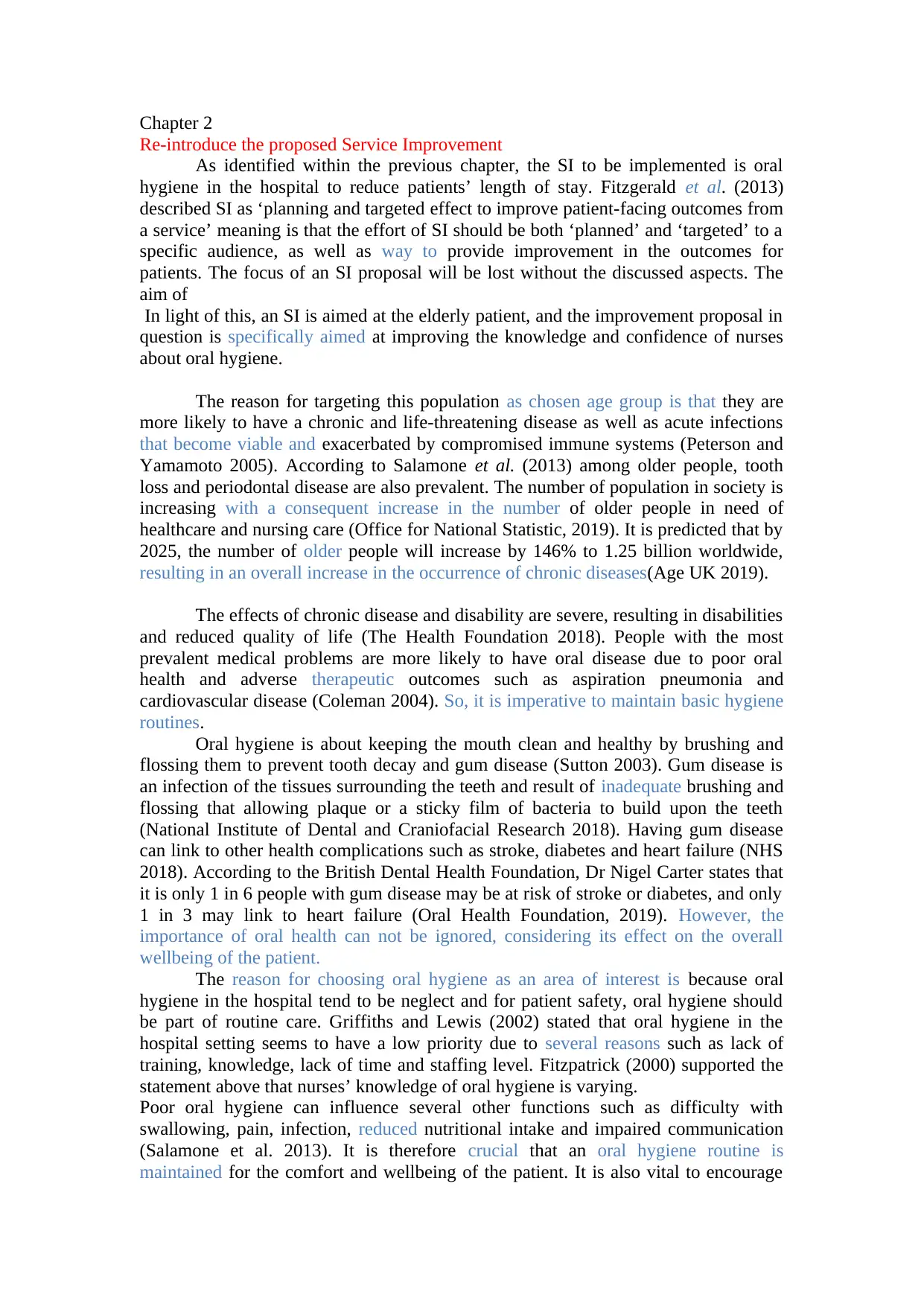
Chapter 2
Re-introduce the proposed Service Improvement
As identified within the previous chapter, the SI to be implemented is oral
hygiene in the hospital to reduce patients’ length of stay. Fitzgerald et al. (2013)
described SI as ‘planning and targeted effect to improve patient-facing outcomes from
a service’ meaning is that the effort of SI should be both ‘planned’ and ‘targeted’ to a
specific audience, as well as way to provide improvement in the outcomes for
patients. The focus of an SI proposal will be lost without the discussed aspects. The
aim of
In light of this, an SI is aimed at the elderly patient, and the improvement proposal in
question is specifically aimed at improving the knowledge and confidence of nurses
about oral hygiene.
The reason for targeting this population as chosen age group is that they are
more likely to have a chronic and life-threatening disease as well as acute infections
that become viable and exacerbated by compromised immune systems (Peterson and
Yamamoto 2005). According to Salamone et al. (2013) among older people, tooth
loss and periodontal disease are also prevalent. The number of population in society is
increasing with a consequent increase in the number of older people in need of
healthcare and nursing care (Office for National Statistic, 2019). It is predicted that by
2025, the number of older people will increase by 146% to 1.25 billion worldwide,
resulting in an overall increase in the occurrence of chronic diseases(Age UK 2019).
The effects of chronic disease and disability are severe, resulting in disabilities
and reduced quality of life (The Health Foundation 2018). People with the most
prevalent medical problems are more likely to have oral disease due to poor oral
health and adverse therapeutic outcomes such as aspiration pneumonia and
cardiovascular disease (Coleman 2004). So, it is imperative to maintain basic hygiene
routines.
Oral hygiene is about keeping the mouth clean and healthy by brushing and
flossing them to prevent tooth decay and gum disease (Sutton 2003). Gum disease is
an infection of the tissues surrounding the teeth and result of inadequate brushing and
flossing that allowing plaque or a sticky film of bacteria to build upon the teeth
(National Institute of Dental and Craniofacial Research 2018). Having gum disease
can link to other health complications such as stroke, diabetes and heart failure (NHS
2018). According to the British Dental Health Foundation, Dr Nigel Carter states that
it is only 1 in 6 people with gum disease may be at risk of stroke or diabetes, and only
1 in 3 may link to heart failure (Oral Health Foundation, 2019). However, the
importance of oral health can not be ignored, considering its effect on the overall
wellbeing of the patient.
The reason for choosing oral hygiene as an area of interest is because oral
hygiene in the hospital tend to be neglect and for patient safety, oral hygiene should
be part of routine care. Griffiths and Lewis (2002) stated that oral hygiene in the
hospital setting seems to have a low priority due to several reasons such as lack of
training, knowledge, lack of time and staffing level. Fitzpatrick (2000) supported the
statement above that nurses’ knowledge of oral hygiene is varying.
Poor oral hygiene can influence several other functions such as difficulty with
swallowing, pain, infection, reduced nutritional intake and impaired communication
(Salamone et al. 2013). It is therefore crucial that an oral hygiene routine is
maintained for the comfort and wellbeing of the patient. It is also vital to encourage
Re-introduce the proposed Service Improvement
As identified within the previous chapter, the SI to be implemented is oral
hygiene in the hospital to reduce patients’ length of stay. Fitzgerald et al. (2013)
described SI as ‘planning and targeted effect to improve patient-facing outcomes from
a service’ meaning is that the effort of SI should be both ‘planned’ and ‘targeted’ to a
specific audience, as well as way to provide improvement in the outcomes for
patients. The focus of an SI proposal will be lost without the discussed aspects. The
aim of
In light of this, an SI is aimed at the elderly patient, and the improvement proposal in
question is specifically aimed at improving the knowledge and confidence of nurses
about oral hygiene.
The reason for targeting this population as chosen age group is that they are
more likely to have a chronic and life-threatening disease as well as acute infections
that become viable and exacerbated by compromised immune systems (Peterson and
Yamamoto 2005). According to Salamone et al. (2013) among older people, tooth
loss and periodontal disease are also prevalent. The number of population in society is
increasing with a consequent increase in the number of older people in need of
healthcare and nursing care (Office for National Statistic, 2019). It is predicted that by
2025, the number of older people will increase by 146% to 1.25 billion worldwide,
resulting in an overall increase in the occurrence of chronic diseases(Age UK 2019).
The effects of chronic disease and disability are severe, resulting in disabilities
and reduced quality of life (The Health Foundation 2018). People with the most
prevalent medical problems are more likely to have oral disease due to poor oral
health and adverse therapeutic outcomes such as aspiration pneumonia and
cardiovascular disease (Coleman 2004). So, it is imperative to maintain basic hygiene
routines.
Oral hygiene is about keeping the mouth clean and healthy by brushing and
flossing them to prevent tooth decay and gum disease (Sutton 2003). Gum disease is
an infection of the tissues surrounding the teeth and result of inadequate brushing and
flossing that allowing plaque or a sticky film of bacteria to build upon the teeth
(National Institute of Dental and Craniofacial Research 2018). Having gum disease
can link to other health complications such as stroke, diabetes and heart failure (NHS
2018). According to the British Dental Health Foundation, Dr Nigel Carter states that
it is only 1 in 6 people with gum disease may be at risk of stroke or diabetes, and only
1 in 3 may link to heart failure (Oral Health Foundation, 2019). However, the
importance of oral health can not be ignored, considering its effect on the overall
wellbeing of the patient.
The reason for choosing oral hygiene as an area of interest is because oral
hygiene in the hospital tend to be neglect and for patient safety, oral hygiene should
be part of routine care. Griffiths and Lewis (2002) stated that oral hygiene in the
hospital setting seems to have a low priority due to several reasons such as lack of
training, knowledge, lack of time and staffing level. Fitzpatrick (2000) supported the
statement above that nurses’ knowledge of oral hygiene is varying.
Poor oral hygiene can influence several other functions such as difficulty with
swallowing, pain, infection, reduced nutritional intake and impaired communication
(Salamone et al. 2013). It is therefore crucial that an oral hygiene routine is
maintained for the comfort and wellbeing of the patient. It is also vital to encourage
Paraphrase This Document
Need a fresh take? Get an instant paraphrase of this document with our AI Paraphraser
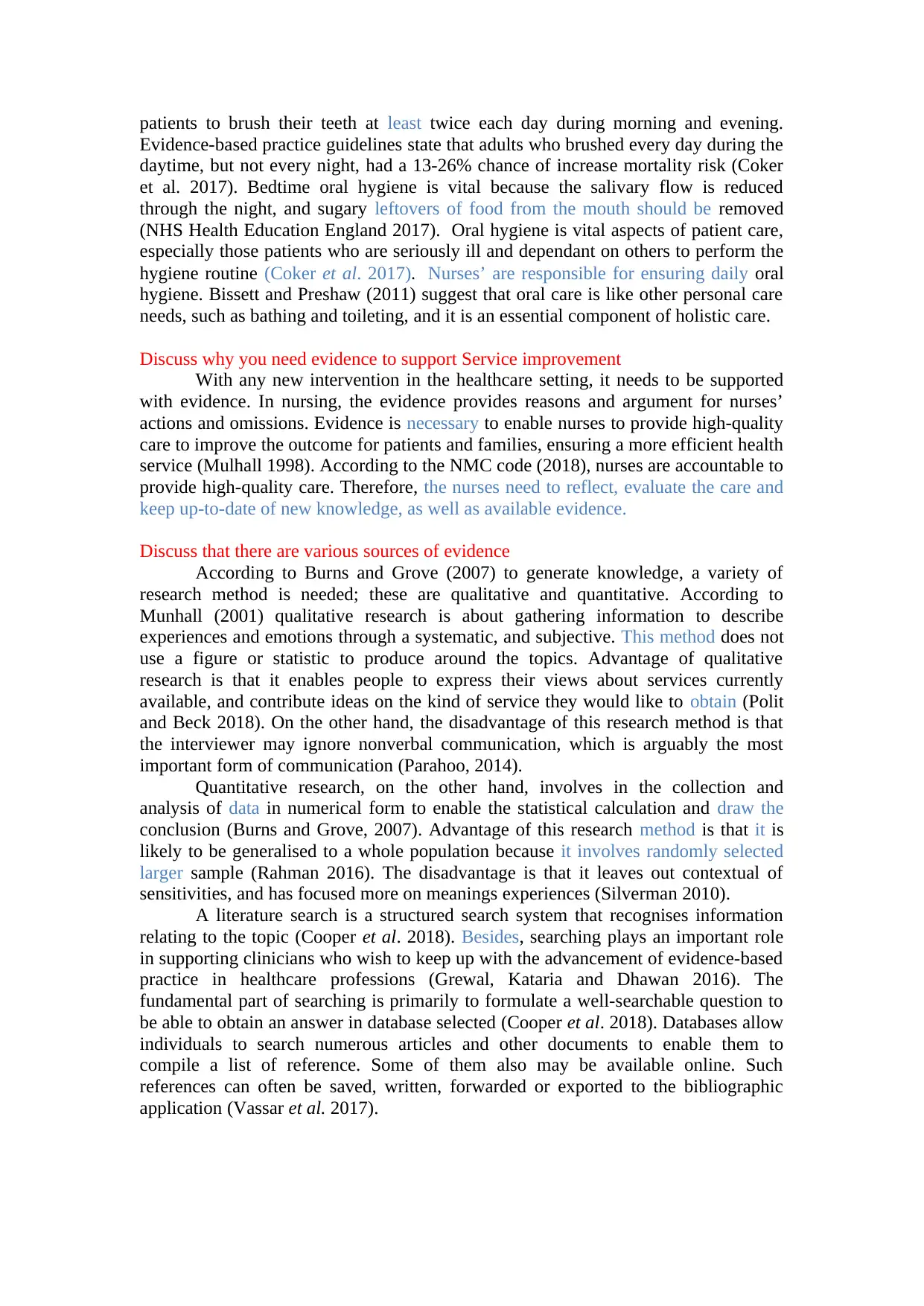
patients to brush their teeth at least twice each day during morning and evening.
Evidence-based practice guidelines state that adults who brushed every day during the
daytime, but not every night, had a 13-26% chance of increase mortality risk (Coker
et al. 2017). Bedtime oral hygiene is vital because the salivary flow is reduced
through the night, and sugary leftovers of food from the mouth should be removed
(NHS Health Education England 2017). Oral hygiene is vital aspects of patient care,
especially those patients who are seriously ill and dependant on others to perform the
hygiene routine (Coker et al. 2017). Nurses’ are responsible for ensuring daily oral
hygiene. Bissett and Preshaw (2011) suggest that oral care is like other personal care
needs, such as bathing and toileting, and it is an essential component of holistic care.
Discuss why you need evidence to support Service improvement
With any new intervention in the healthcare setting, it needs to be supported
with evidence. In nursing, the evidence provides reasons and argument for nurses’
actions and omissions. Evidence is necessary to enable nurses to provide high-quality
care to improve the outcome for patients and families, ensuring a more efficient health
service (Mulhall 1998). According to the NMC code (2018), nurses are accountable to
provide high-quality care. Therefore, the nurses need to reflect, evaluate the care and
keep up-to-date of new knowledge, as well as available evidence.
Discuss that there are various sources of evidence
According to Burns and Grove (2007) to generate knowledge, a variety of
research method is needed; these are qualitative and quantitative. According to
Munhall (2001) qualitative research is about gathering information to describe
experiences and emotions through a systematic, and subjective. This method does not
use a figure or statistic to produce around the topics. Advantage of qualitative
research is that it enables people to express their views about services currently
available, and contribute ideas on the kind of service they would like to obtain (Polit
and Beck 2018). On the other hand, the disadvantage of this research method is that
the interviewer may ignore nonverbal communication, which is arguably the most
important form of communication (Parahoo, 2014).
Quantitative research, on the other hand, involves in the collection and
analysis of data in numerical form to enable the statistical calculation and draw the
conclusion (Burns and Grove, 2007). Advantage of this research method is that it is
likely to be generalised to a whole population because it involves randomly selected
larger sample (Rahman 2016). The disadvantage is that it leaves out contextual of
sensitivities, and has focused more on meanings experiences (Silverman 2010).
A literature search is a structured search system that recognises information
relating to the topic (Cooper et al. 2018). Besides, searching plays an important role
in supporting clinicians who wish to keep up with the advancement of evidence-based
practice in healthcare professions (Grewal, Kataria and Dhawan 2016). The
fundamental part of searching is primarily to formulate a well-searchable question to
be able to obtain an answer in database selected (Cooper et al. 2018). Databases allow
individuals to search numerous articles and other documents to enable them to
compile a list of reference. Some of them also may be available online. Such
references can often be saved, written, forwarded or exported to the bibliographic
application (Vassar et al. 2017).
Evidence-based practice guidelines state that adults who brushed every day during the
daytime, but not every night, had a 13-26% chance of increase mortality risk (Coker
et al. 2017). Bedtime oral hygiene is vital because the salivary flow is reduced
through the night, and sugary leftovers of food from the mouth should be removed
(NHS Health Education England 2017). Oral hygiene is vital aspects of patient care,
especially those patients who are seriously ill and dependant on others to perform the
hygiene routine (Coker et al. 2017). Nurses’ are responsible for ensuring daily oral
hygiene. Bissett and Preshaw (2011) suggest that oral care is like other personal care
needs, such as bathing and toileting, and it is an essential component of holistic care.
Discuss why you need evidence to support Service improvement
With any new intervention in the healthcare setting, it needs to be supported
with evidence. In nursing, the evidence provides reasons and argument for nurses’
actions and omissions. Evidence is necessary to enable nurses to provide high-quality
care to improve the outcome for patients and families, ensuring a more efficient health
service (Mulhall 1998). According to the NMC code (2018), nurses are accountable to
provide high-quality care. Therefore, the nurses need to reflect, evaluate the care and
keep up-to-date of new knowledge, as well as available evidence.
Discuss that there are various sources of evidence
According to Burns and Grove (2007) to generate knowledge, a variety of
research method is needed; these are qualitative and quantitative. According to
Munhall (2001) qualitative research is about gathering information to describe
experiences and emotions through a systematic, and subjective. This method does not
use a figure or statistic to produce around the topics. Advantage of qualitative
research is that it enables people to express their views about services currently
available, and contribute ideas on the kind of service they would like to obtain (Polit
and Beck 2018). On the other hand, the disadvantage of this research method is that
the interviewer may ignore nonverbal communication, which is arguably the most
important form of communication (Parahoo, 2014).
Quantitative research, on the other hand, involves in the collection and
analysis of data in numerical form to enable the statistical calculation and draw the
conclusion (Burns and Grove, 2007). Advantage of this research method is that it is
likely to be generalised to a whole population because it involves randomly selected
larger sample (Rahman 2016). The disadvantage is that it leaves out contextual of
sensitivities, and has focused more on meanings experiences (Silverman 2010).
A literature search is a structured search system that recognises information
relating to the topic (Cooper et al. 2018). Besides, searching plays an important role
in supporting clinicians who wish to keep up with the advancement of evidence-based
practice in healthcare professions (Grewal, Kataria and Dhawan 2016). The
fundamental part of searching is primarily to formulate a well-searchable question to
be able to obtain an answer in database selected (Cooper et al. 2018). Databases allow
individuals to search numerous articles and other documents to enable them to
compile a list of reference. Some of them also may be available online. Such
references can often be saved, written, forwarded or exported to the bibliographic
application (Vassar et al. 2017).
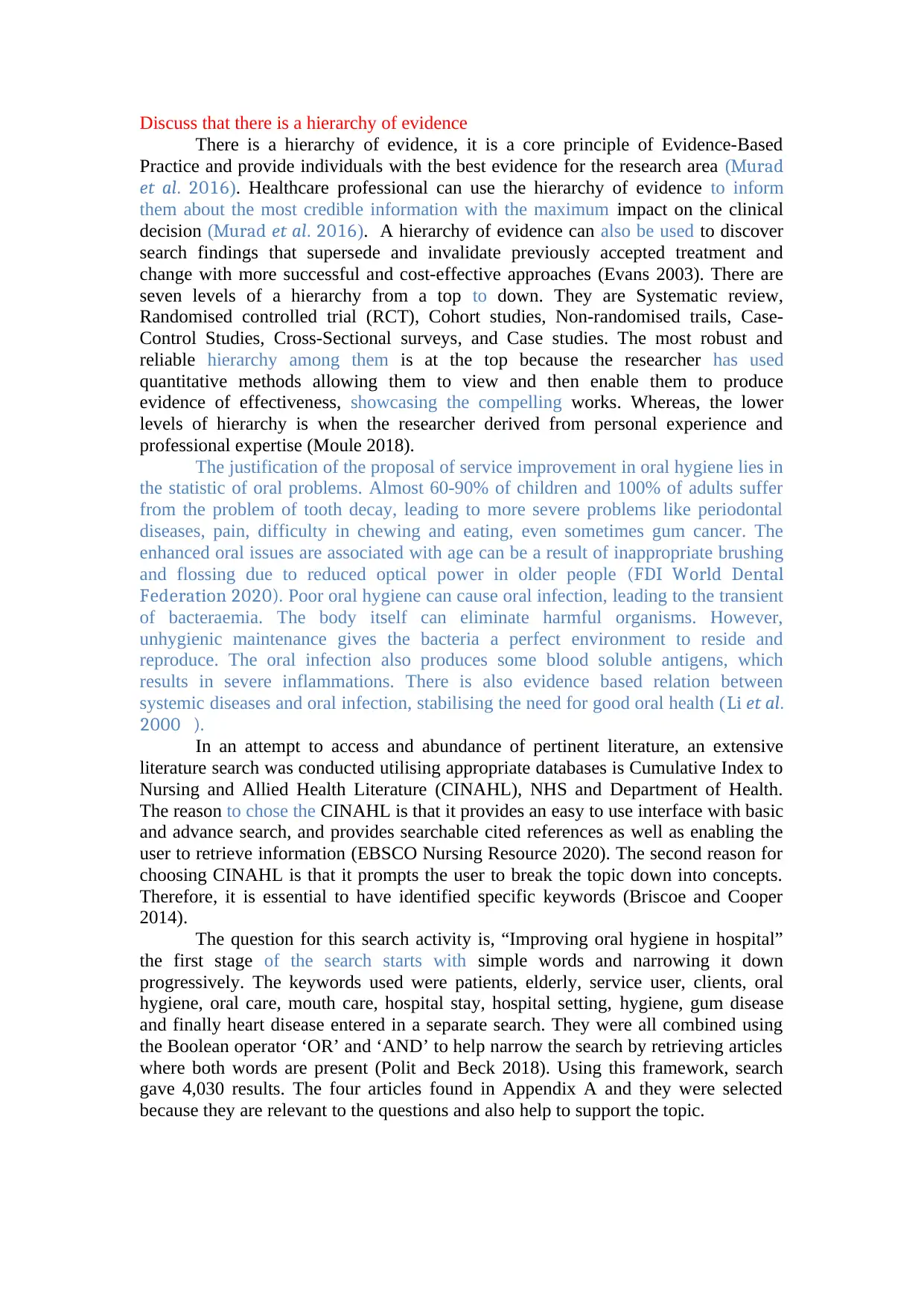
Discuss that there is a hierarchy of evidence
There is a hierarchy of evidence, it is a core principle of Evidence-Based
Practice and provide individuals with the best evidence for the research area (Murad
et al. 2016). Healthcare professional can use the hierarchy of evidence to inform
them about the most credible information with the maximum impact on the clinical
decision (Murad et al. 2016). A hierarchy of evidence can also be used to discover
search findings that supersede and invalidate previously accepted treatment and
change with more successful and cost-effective approaches (Evans 2003). There are
seven levels of a hierarchy from a top to down. They are Systematic review,
Randomised controlled trial (RCT), Cohort studies, Non-randomised trails, Case-
Control Studies, Cross-Sectional surveys, and Case studies. The most robust and
reliable hierarchy among them is at the top because the researcher has used
quantitative methods allowing them to view and then enable them to produce
evidence of effectiveness, showcasing the compelling works. Whereas, the lower
levels of hierarchy is when the researcher derived from personal experience and
professional expertise (Moule 2018).
The justification of the proposal of service improvement in oral hygiene lies in
the statistic of oral problems. Almost 60-90% of children and 100% of adults suffer
from the problem of tooth decay, leading to more severe problems like periodontal
diseases, pain, difficulty in chewing and eating, even sometimes gum cancer. The
enhanced oral issues are associated with age can be a result of inappropriate brushing
and flossing due to reduced optical power in older people (FDI World Dental
Federation 2020). Poor oral hygiene can cause oral infection, leading to the transient
of bacteraemia. The body itself can eliminate harmful organisms. However,
unhygienic maintenance gives the bacteria a perfect environment to reside and
reproduce. The oral infection also produces some blood soluble antigens, which
results in severe inflammations. There is also evidence based relation between
systemic diseases and oral infection, stabilising the need for good oral health (Li et al.
2000 ).
In an attempt to access and abundance of pertinent literature, an extensive
literature search was conducted utilising appropriate databases is Cumulative Index to
Nursing and Allied Health Literature (CINAHL), NHS and Department of Health.
The reason to chose the CINAHL is that it provides an easy to use interface with basic
and advance search, and provides searchable cited references as well as enabling the
user to retrieve information (EBSCO Nursing Resource 2020). The second reason for
choosing CINAHL is that it prompts the user to break the topic down into concepts.
Therefore, it is essential to have identified specific keywords (Briscoe and Cooper
2014).
The question for this search activity is, “Improving oral hygiene in hospital”
the first stage of the search starts with simple words and narrowing it down
progressively. The keywords used were patients, elderly, service user, clients, oral
hygiene, oral care, mouth care, hospital stay, hospital setting, hygiene, gum disease
and finally heart disease entered in a separate search. They were all combined using
the Boolean operator ‘OR’ and ‘AND’ to help narrow the search by retrieving articles
where both words are present (Polit and Beck 2018). Using this framework, search
gave 4,030 results. The four articles found in Appendix A and they were selected
because they are relevant to the questions and also help to support the topic.
There is a hierarchy of evidence, it is a core principle of Evidence-Based
Practice and provide individuals with the best evidence for the research area (Murad
et al. 2016). Healthcare professional can use the hierarchy of evidence to inform
them about the most credible information with the maximum impact on the clinical
decision (Murad et al. 2016). A hierarchy of evidence can also be used to discover
search findings that supersede and invalidate previously accepted treatment and
change with more successful and cost-effective approaches (Evans 2003). There are
seven levels of a hierarchy from a top to down. They are Systematic review,
Randomised controlled trial (RCT), Cohort studies, Non-randomised trails, Case-
Control Studies, Cross-Sectional surveys, and Case studies. The most robust and
reliable hierarchy among them is at the top because the researcher has used
quantitative methods allowing them to view and then enable them to produce
evidence of effectiveness, showcasing the compelling works. Whereas, the lower
levels of hierarchy is when the researcher derived from personal experience and
professional expertise (Moule 2018).
The justification of the proposal of service improvement in oral hygiene lies in
the statistic of oral problems. Almost 60-90% of children and 100% of adults suffer
from the problem of tooth decay, leading to more severe problems like periodontal
diseases, pain, difficulty in chewing and eating, even sometimes gum cancer. The
enhanced oral issues are associated with age can be a result of inappropriate brushing
and flossing due to reduced optical power in older people (FDI World Dental
Federation 2020). Poor oral hygiene can cause oral infection, leading to the transient
of bacteraemia. The body itself can eliminate harmful organisms. However,
unhygienic maintenance gives the bacteria a perfect environment to reside and
reproduce. The oral infection also produces some blood soluble antigens, which
results in severe inflammations. There is also evidence based relation between
systemic diseases and oral infection, stabilising the need for good oral health (Li et al.
2000 ).
In an attempt to access and abundance of pertinent literature, an extensive
literature search was conducted utilising appropriate databases is Cumulative Index to
Nursing and Allied Health Literature (CINAHL), NHS and Department of Health.
The reason to chose the CINAHL is that it provides an easy to use interface with basic
and advance search, and provides searchable cited references as well as enabling the
user to retrieve information (EBSCO Nursing Resource 2020). The second reason for
choosing CINAHL is that it prompts the user to break the topic down into concepts.
Therefore, it is essential to have identified specific keywords (Briscoe and Cooper
2014).
The question for this search activity is, “Improving oral hygiene in hospital”
the first stage of the search starts with simple words and narrowing it down
progressively. The keywords used were patients, elderly, service user, clients, oral
hygiene, oral care, mouth care, hospital stay, hospital setting, hygiene, gum disease
and finally heart disease entered in a separate search. They were all combined using
the Boolean operator ‘OR’ and ‘AND’ to help narrow the search by retrieving articles
where both words are present (Polit and Beck 2018). Using this framework, search
gave 4,030 results. The four articles found in Appendix A and they were selected
because they are relevant to the questions and also help to support the topic.
⊘ This is a preview!⊘
Do you want full access?
Subscribe today to unlock all pages.

Trusted by 1+ million students worldwide
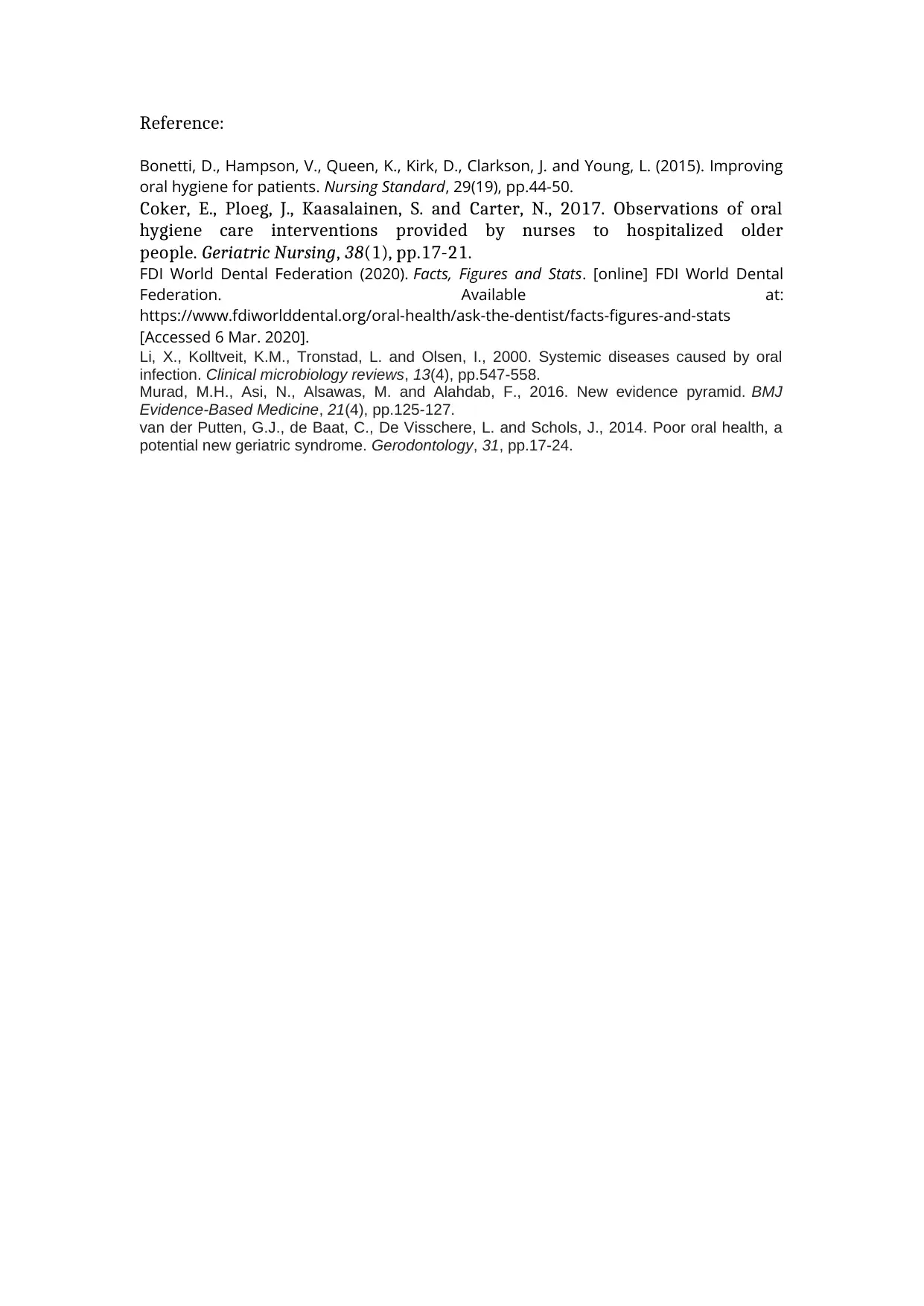
Reference:
Bonetti, D., Hampson, V., Queen, K., Kirk, D., Clarkson, J. and Young, L. (2015). Improving
oral hygiene for patients. Nursing Standard, 29(19), pp.44-50.
Coker, E., Ploeg, J., Kaasalainen, S. and Carter, N., 2017. Observations of oral
hygiene care interventions provided by nurses to hospitalized older
people. Geriatric Nursing, 38(1), pp.17-21.
FDI World Dental Federation (2020). Facts, Figures and Stats. [online] FDI World Dental
Federation. Available at:
https://www.fdiworlddental.org/oral-health/ask-the-dentist/facts-figures-and-stats
[Accessed 6 Mar. 2020].
Li, X., Kolltveit, K.M., Tronstad, L. and Olsen, I., 2000. Systemic diseases caused by oral
infection. Clinical microbiology reviews, 13(4), pp.547-558.
Murad, M.H., Asi, N., Alsawas, M. and Alahdab, F., 2016. New evidence pyramid. BMJ
Evidence-Based Medicine, 21(4), pp.125-127.
van der Putten, G.J., de Baat, C., De Visschere, L. and Schols, J., 2014. Poor oral health, a
potential new geriatric syndrome. Gerodontology, 31, pp.17-24.
Bonetti, D., Hampson, V., Queen, K., Kirk, D., Clarkson, J. and Young, L. (2015). Improving
oral hygiene for patients. Nursing Standard, 29(19), pp.44-50.
Coker, E., Ploeg, J., Kaasalainen, S. and Carter, N., 2017. Observations of oral
hygiene care interventions provided by nurses to hospitalized older
people. Geriatric Nursing, 38(1), pp.17-21.
FDI World Dental Federation (2020). Facts, Figures and Stats. [online] FDI World Dental
Federation. Available at:
https://www.fdiworlddental.org/oral-health/ask-the-dentist/facts-figures-and-stats
[Accessed 6 Mar. 2020].
Li, X., Kolltveit, K.M., Tronstad, L. and Olsen, I., 2000. Systemic diseases caused by oral
infection. Clinical microbiology reviews, 13(4), pp.547-558.
Murad, M.H., Asi, N., Alsawas, M. and Alahdab, F., 2016. New evidence pyramid. BMJ
Evidence-Based Medicine, 21(4), pp.125-127.
van der Putten, G.J., de Baat, C., De Visschere, L. and Schols, J., 2014. Poor oral health, a
potential new geriatric syndrome. Gerodontology, 31, pp.17-24.
1 out of 7
Related Documents
Your All-in-One AI-Powered Toolkit for Academic Success.
+13062052269
info@desklib.com
Available 24*7 on WhatsApp / Email
![[object Object]](/_next/static/media/star-bottom.7253800d.svg)
Unlock your academic potential
Copyright © 2020–2025 A2Z Services. All Rights Reserved. Developed and managed by ZUCOL.





